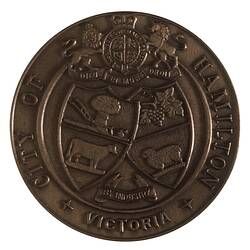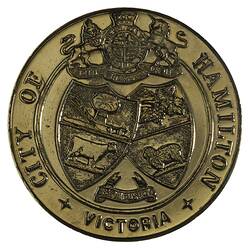Hamilton City Council was located west of Melbourne, in inland Victoria. The land originally belonged to three Aboriginal tribes: the Gunditjmara land that stretches south to the coast, the Tjapwurong land to the north east and the Bunganditj territory which spreads west into South Australia. They built structures such as the fish traps which can be seen in the Lake Condah area to the south of Hamilton.
On 12 September 1836 Major Thomas Mitchell became the first European to travel through the area. His reports about agricultural potential were enthusiastic, and pastoralists soon moved into the area and established large runs, mainly running sheep. Indigenous peoples of the area mounted a strong guerilla resistance to the occupation of their land. The inability of the two groups to reconcile their land use priorities contributed to many deaths in the Western District. In 1841 a detachment of mounted police was based at a pastoral property called the 'Grange', now the site of Hamilton, to put down Aboriginal resistance. The first constable appointed opened the Green Inn, and the following year a blacksmith established a smithy at the Grange. The police departed in 1844, but not before the Western District Protectorate was established by Charles Sievwright and an Aboriginal Reserve was built at Mount Rouse, south-east of Hamilton. Up to 300 Aborigines lived there until it ceased in 1850. A Keeping Place, a small museum of Aboriginal culture, was established in Hamilton in the later twentieth century and contains various artefacts, crafts and information concerning the local Aboriginal tribes.
The township of Hamilton was formally established in 1851. In the early 1850s land was surveyed for agricultural allotments, and the first selectors arrived in the Hamilton district. Amongst the first of the pioneering farmers were a significant number of German Lutherans who established several communities in the district. The pastoral and agricultural properties of the Hamilton district generally flourished. The gold rushes in the Ararat and Ballarat areas provided a ready market for the primary produce of the district. By the 1860s Hamilton was an important township with many services. The Borough of Hamilton was created in 1863.
The 1870s and 1880s saw the town take on a more established appearance, and the railway arrived in 1877. By 1881 Hamilton had a population of 2967.
Victoria introduced Protection in 1865, which saw Border customs houses established and restricted the flow of exports from South Australia to the Hamilton district. The Hamilton Spectator reported in January 1870 that a petition was being forwarded to the Commissioner of Customs by the residents of Coleraine and the surrounding district, who were unhappy about the 3s per gallon duty that they were required to pay on wine imported from South Australia.
Hamilton was proclaimed a town in 1928 and a city in 1949.
Hamilton City Council issued a medal in 1985 to commemorate the sesquicentenary of Victoria (NU 20700).
On 23 September 1994 the City of Hamilton, Shire of Wannon, part of Shires of Dundas, Kowree, Mount Rouse and Heywood united to form the Southern Grampians Shire Council.
References:
Municipal Association of Victoria website http://www.mav.asn.au, accessed 16/01/2004.
People's Voice: Australian Community History On-line website http://www.peoplesvoice.gov.au/stories/vic/hamilton/hamilton_c.htm, accessed 16/01/2004.
Blake, L. (1977). Place Names of Victoria.
More Information
-
Keywords
-
Localities
-
Authors
-
Article types


